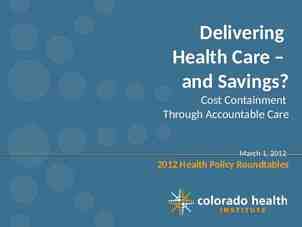Technical Assistance for Brownfields EPA Region 1 EPA MAC Grants:
25 Slides6.68 MB
Technical Assistance for Brownfields EPA Region 1 EPA MAC Grants: Displacement Katie Malgioglio, MSW: UConn TAB Community Liaison & Community Engagement Coordinator Rupal Parekh, PhD: Assistant Professor, UConn School of Social Work & UConn TAB Community Engagement Coordinator University of Connecticut October 18, 2023
1. MAC Grants 2. Displacement Overview I. II. Webinar Outline Definition Brief Summary (who, what, where, when, why?) III. Statistics & Impacts IV. Displacement & Brownfields 3. Grant-Writing Guidelines I. Environmental Justice 4. Anti-Displacement Strategies 5. Grant Example 6. Questions
Grant Type Maximum Project Period Award Funding Number of Awards Anticipated Community-Wide Assessment 4 years Up to 500,000 per applicant 60 Assessment Coalitions 5 years Up to 1,500,000 per applicant 26 Cleanup 4 years Up to 500,000, up to 2,000,000, or up to 5,000,000 per applicant 65 (40 awards at 500,000 17 awards at 2,000,000 8 awards at 5,000,000) Multipurpose 5 years Up to 1,000,000 per applicant 20 MAC Grants
What is Displacement? Direct Displacement: occurs when residents are forced to relocate due to eviction, environmental hazards, or redevelopment of the buildings they live in Indirect Displacement: occurs when residents can no longer afford to remain in their homes/neighborhoods due to increasing rents Cultural Displacement: occurs when the character/culture of a neighborhood changes due to people leaving while new residents and businesses move in Source: Thriving in Place
Gentrification vs. Displacement Displacement: the forced relocation of residents and businesses Gentrification: neighborhoods changing when places of low real estate value are redeveloped, transformed, or “revitalized” into places of high real estate value (gentrification often attracts new businesses and new residents) These two concepts are often connected (with gentrification leading to displacement) - but they do not have to be!
Have you seen gentrification and/or displacement in your communities? What was this experience like?
Cultural Displacement Where? Who? When? Why? What? Displacement Displacemen Main drivers People of Forced often occurs t has been of relocation of color, lowin urban income on the rise in displacemen a areas and populations, the U.S. t: rising cost community' major cities adults with since the of living, lack s existing New England no college 1960s. of affordable residents examples: degree, housing, Can be a and Hartford, CT older adults, redlining, result of - Boston, MA businesses and families with children are most vulnerable to displacemen t - Providence, RI - Portsmouth, NH - Portland, ME - Burlington, VT gentrification , revitalization , redevelopme nt projects, etc. and neighborhoo d revitalization
Displacement Throughout the U.S. 1960s: population was 90% Black 2023: population is 9% Black Displacement of Asian community in Flushing, Queens Portland, Oregon Seattle, Washington Los Angeles, California New York City, New York Between 2000 and 2010, 10,000 Black Americans were displaced 80,000 people in this city are currently at risk of displacement Atlanta, Georgia Low-income neighborhoods were "modernized" in early 2000s, leading to displacement
Putting Displacement into Perspective. o Nationally, 73% of Black renters and 63% of Hispanic renters currently live in neighborhoods with high risk of displacement or eviction ( U.C. Berkley's Urban Displacement Project) o Boston is the 3rd "most intensely gentrified city" in the U.S. (National Community Reinvestment Coalition) o Displacement intensifies poverty conditions, prevents economic mobility, and limits access to important services o Displacement has negative impacts on physical health, mental health, and healthcare access (CDC) Displaced populations are reported to experience higher rates of stress, depression, cancer, cardiovascular disease, and infant mortality/birth defects
Displacement and Brownfields Redevelopment Brownfields redevelopment can present opportunity and transformation within communities, but the process can also present challenges: - Complex regulations - Limited capacity within local government - Revitalized brownfields can increase taxes and cost of living, leading to possibility of displacement Brownfields redevelopment should aim to promote equity, advance environmental justice, and minimize community displacement by protecting culture, residents, and small businesses
Section II of Narrative a. Community Need i. The Community’s Need for Funding ii. Threats to Sensitive Populations 1) Health or Welfare of Sensitive Populations (5 pts) 2) Greater than Normal Incidence of Disease and Adverse Health Conditions (5pts) 3) Environmental Justice (10 pts) a) Identification of EJ Issues b) Advancing EJ: discuss how [this grant] will advance environmental justice and minimize displacement of residents and/or businesses in underserved communities in the target area
Displacement and Environmental Justice EPA Definition: "Environmental justice is the fair treatment and meaningful involvement of all people regardless of race, color, national origin, or income, with respect to the development, implementation, and enforcement of environmental laws, regulations, and policies. This goal will be achieved when everyone enjoys: o The same degree of protection from environmental and health hazards, and o Equal access to the decision-making process to have a healthy environment in which to live, learn, and work." Equal access to decision-making processes about environment and health residents and businesses being able to comfortably stay in their neighborhoods as brownfields are being revitalized and redeveloped
Discussing Displacement on MAC Grants (FY24) Identify displacement that will possibly occur Measurement and Evaluation: develop metrics to evaluate displacement potential (property values, rent, vacancy rates, demographics) Develop an anti-displacement plan that is tailored for your municipality Acknowledge the connection between displacement and environmental justice Prioritize sensitive, underserved populations Protecting the rights of current residents, small businesses, and underserved groups in your community is advancing environmental justice!
Anti-Displacement Strategies Community Benefits Agreements Contract between community members and private developer Outlines community needs and desired outcomes Community Land Inclusionary Trusts Zoning When a non-profit organization purchases housing/land to sell to residents at affordable price A local policy that requires a certain amount of affordable housing units within a community Small Business Preservation Programs Programs that support small businesses through funding, workforce development, etc. Tax Abatement Financial programs and tax reductions aiming to protect residents/businesses from rising costs of living
Do you have experience with any of these strategies? Did any of them seem like a good fit for your own anti-displacement plans?
Example: There are significant efforts underway to minimize displacement and protect quality of life for existing residents while also leveraging the benefits of economic growth. The target area's neighborhood association and municipal government (partnered with identified stakeholders from Section 2b) have been working towards the creation of a Community Benefits Agreement (CBA). The CBA will outline community needs, desired benefits of residents and local businesses, and how funding for this project will be used. Keeping residents and businesses in their neighborhoods is an integral to the CBA and (town/city)'s overall vision. The CBA will be initiated with stakeholders prior to redevelopment and utilize community engagement tactics to ensure underserved groups are supported throughout the redevelopment process. - Identify and name displacement - List specific strategy for minimizing and combatting displacement - Acknowledge importance of protecting current residents / businesses
Contacts Rupal Parekh, PhD Community Engagement Coordinator Assistant Professor UConn School of Social Work [email protected] Katie Malgioglio, MSW Community Liaison Community Engagement Coordinator UConn Technical Assistance for Brownfields [email protected] [email protected] tab.program.uconn.edu
Community Engagement in Practice
Community Engagement in Practice
Community Engagement in Practice
Community Engagement in Practice
Community Engagement in Practice






























